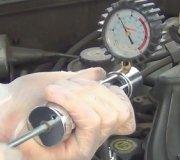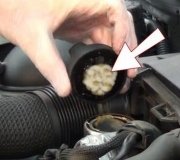Hi and thanks for using 2CarPros.com.
It sounds like you have already done a good job testing for a bad head gasket. However, since you feel the tests are inconclusive, I would recommend checking engine compression.
First, here is a link that discusses how to test for a blown head gasket:
https://www.2carpros.com/articles/head-gasket-blown-test
Here is a link that discusses how to check engine compression:
https://www.2carpros.com/articles/how-to-test-engine-compression
___________________
Here are directions specific to your vehicle.
YLINDER COMPRESSION PRESSURE TEST
The results of a cylinder compression pressure test can be utilized to diagnose several engine malfunctions.
Ensure the battery is completely charged and the engine starter motor is in good operating condition. Otherwise the indicated compression pressures may not be valid for diagnosis purposes.
1. Clean the spark plug recesses with compressed air.
2. Remove the spark plugs.
3. Secure the throttle in the wide-open position.
4. Disable the fuel system.
5. Disconnect the ignition coil.
6. Insert a compression pressure gauge and rotate the engine with the engine starter motor for three revolutions.
7. Record the compression pressure on the 3rd revolution. Continue the test for the remaining cylinders.
Here are the specs for your engine:
NOTE: This six-cylinder engine is an In-line, lightweight, overhead valve engine.
Engine Type .................... In-line 6 Cylinder
Compression Ratio .................... 8.7:1
Pressure Range .................... 827 - 1,034 kPa (120 - 150 psi)
Max. Variation Between Cylinders .................... 206 kPa(30 psi)
___________________________________
With that being said, I will tell you that there has been a problem with the 1999 and 2000 4L engines. What often times happens with these engines is the cylinder head will crack between cylinder 3 and 4. Most times, coolant will get into the oil and it is obvious there is a problem. However, I have had them not show the traditional signs. The only indicator was overheating or excessive pressure in the cooling system. Try the compression test to see if there are any variations between the cylinders. Otherwise, you need to remove the head to check for cracks.
________________________________
I wanted to add one more thing for testing. This is right from Alldata and describes how to check different types of failure.
Cylinder-to-cylinder Leakage Test
To determine if an engine cylinder head gasket is leaking between adjacent cylinders; follow the procedures outlined in Cylinder Compression Pressure Test. An engine cylinder head gasket leaking between adjacent cylinders will result in approximately a 50-70% reduction in compression pressure.
Cylinder-to-water Jacket Leakage Test
WARNING: USE EXTREME CAUTION WHEN THE ENGINE IS OPERATING. DO NOT STAND IN A DIRECT LINE WITH THE FAN. DO NOT PUT YOUR HANDS NEAR THE PULLEYS, BELTS OR THE FAN. DO NOT WEAR LOOSE CLOTHING.
Remove the radiator cap.
Start the engine and allow it to warm up until the engine thermostat opens.
If a large combustion/compression pressure leak exists, bubbles will be visible in the coolant.
If bubbles are not visible, install a radiator pressure tester and pressurize the coolant system.
If a cylinder is leaking combustion pressure into the water jacket, the tester pointer will pulsate with every combustion stroke of the cylinder.
Let me know if this helps or if you have other questions.
Take care,
Joe
Saturday, October 6th, 2018 AT 8:59 PM



